#loss 1744
Text

Loss of HMS 'Victory', 4 October 1744
Peter Monamy (1681–1749)
National Maritime Museum
193 notes
·
View notes
Text


[New York, 1746 – First meeting ]
In 1744, King George's War was fought between the British, the British-American forces in the colonies and the Iroquois Confederacy against the French and the Wabanaki Confederacy of New France. Part of the Austrian War of Succession, it was fought mainly in New York and the Massachusetts bay. The battle meant tremendous losses for the colonies, with an estimated loss of 8% of the male population in Massachusetts. The Treaty of Aix-la-Chapelle ended the war in 1748, returning colonial borders back to how they were before the war. Three years later however, the town of Louisbourg was returned to France in exchange for the city of Madras (renamed to Chennai in 1996) in India. This city was captured by the French in September 1746 from the British, thus the "exchange". This angered New Englanders, who provided funding and personnel. The British paid Massachusetts £180,000 (roughly £32,281,486.29 in 2022), which the province then used to retire their currency.
[ Disclaimer : I am not, nor do I claim to be any expert on anything. I am constantly learning, so this post and others like it are subject to retcons and the like. Appropriate warnings will be given as I go. Also, please note that this, whilst based on history, is still a work of fiction. I do not condone nor support generally morally reprehensible things directly mentioned or alluded to on these. ]
1746 was more or less the midpoint of this war (with France launching a major expedition to recapture Louisbourg, the previous figures for Massachusetts losses being from 1745-46, etc.) and so the idea was for Susannah to act as the crown's (and by extension, Arthur's) eyes and ears to the colonies in direct response to the growing unrest. Alfred up until this point had been a loyal and steadfast son and subject, despite his eternal curiosity leading him to consume more and more literature that directly put old beliefs into question. Though he was not initially aware of Susannah's double allegiances, Alfred was aware of the formal, employer-employee arrangement between himself and Susannah. Despite that, his warm personality and similar wavelength of interests allowed him to easily breach the gap between 'acquaintance' and 'friend'. His father was often entire oceans away and this is the first time he met someone whom he could get attached to without fearing their mortality (see: humans Alfred had befriended throughout the years) or any perceived double national interests. The exchange of Louisbourg for Madras had been one of the many events that would plant the idea that his father was not entirely devoted to him in Alfred's mind. His conflicting feelings about the exchange and his place in the empire allowed him to open himself up to befriending Susannah, perhaps thinking that if he behaved well and treated who was essentially a bureaucratic extension of his Lord Father's presence well, perhaps he could earn his favor again.
Susannah on the other hand, was caught off guard by his lack of formality and had even found him to be somewhat "uncultured" in the beginning. The mainland British had mixed feelings about the colonists, but many of them held prejudices and saw them as "uncouth". As Suzie's household had mainly been attendants and tutors brought in from Britain, she shared their beliefs throughout her childhood. But slowly, as Suzie began to spend more time with Alfred, she warmed up to him, happy for the chance to finally be taken seriously instead of waved off for her more intellectual pursuits. Susannah was born in the colonies. But due to her ancestor, Sir Wilfred Knightley, whose affection and counsel she received growing up, her family has and continues to hold deep ties to the crown. Her beliefs and viewpoints were shaped simultaneously by her birthplace and her family's values. Though they were seen as upstarts in Britain, the Knightleys were an esteemed family in the colonies. She interacted with a lot of people from the mainland, a lot of important family friends and other acquaintances, but she'd also spent a lot of time talking to and mingling with colonists, both ranking ones and average, everyday people. To reflect the attitudes of many colonists, Susannah identified as a loyalist up until the middle of the Revolution.
[ commissions open | do not repost ] ocs by sunnysssol
#hetalia#aph america x oc#aph america#aph england#hetalia oc#hws assistantverse#oc: susannah knightley#oc: wilfred knightley#re: amesuzie [ canon timeline ]#[ 18th century ]#cc: alfred f jones#cc: arthur kirkland
91 notes
·
View notes
Text
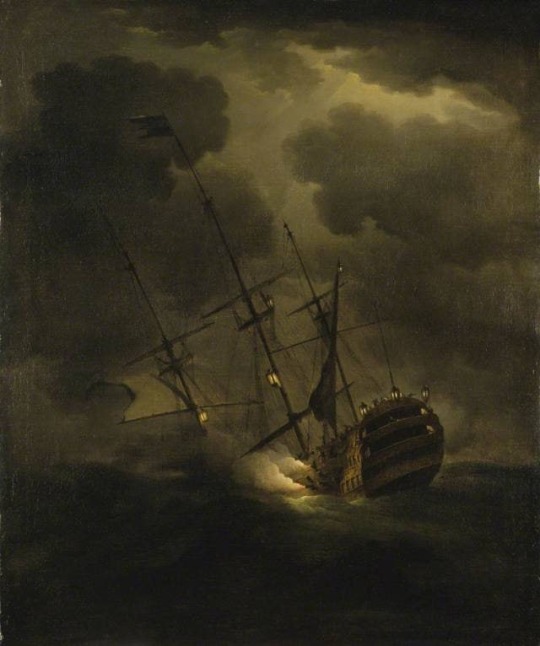
Loss of HMS 'Victory', 4 October 1744
Peter Monamy (1681–1749)
16 notes
·
View notes
Text
Shakespeare Weekend

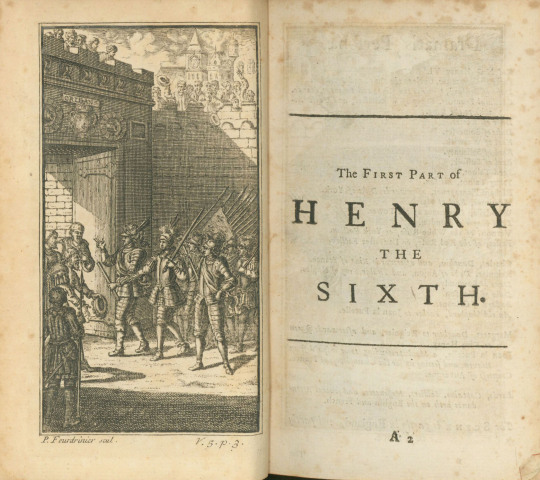
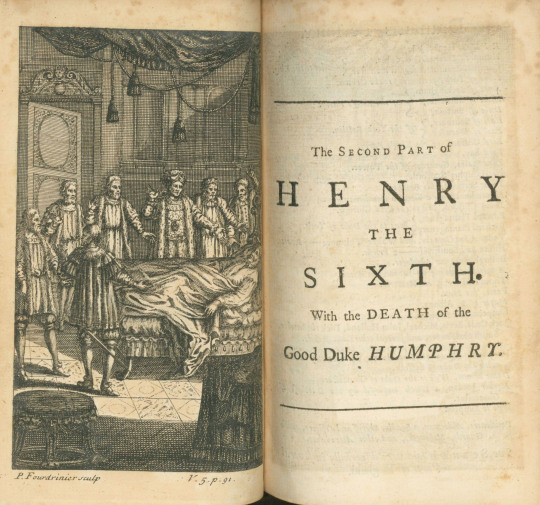


This weekend we return to The works of Mr. William Shakespear: in ten volumes with the fifth volume published in 1728 by Alexander Pope (1688-1744) and Dr. George Sewell (d. 1726) for Jacob Tonson. Volume Five is made up of King Henry VI Part I, King Henry VI Part II, King Henry VI Part III, and King Richard III. The four plays create a tetralogy that covers the entire saga of the Wars of the Roses, a series of 15th century civil wars fought to determine control of the English throne.
King Henry VI Part I enacts the loss of England’s French territories and the political momentum spurring on the Wars of the Roses. Part II delves into King Henry’s failings and the rise of the Duke of York. Part III documents the chaos and horror of war and contains one of the longest soliloquies in all of Shakespeare. The volume ends with King Richard III depicting the violent rise and short reign of King Richard III.
Like Rowe’s earlier collection, scene divisions, stage directions, dramatis personae, and full-page engravings by either French artist Louis Du Guernier (1677-1716) or Englishman Paul Fourdrinier (1698-1758) precede each play.
Pope’s editions of Shakespeare were the first attempted to collate all previous publications. He consulted twenty-seven early quartos restoring passages that had been out of print for almost a century while simultaneously removing about 1,560 lines of material that didn’t appeal to him. Some of those lines were degraded to the bottom of the page with his other editorial notes.
View more Shakespeare Weekend posts.
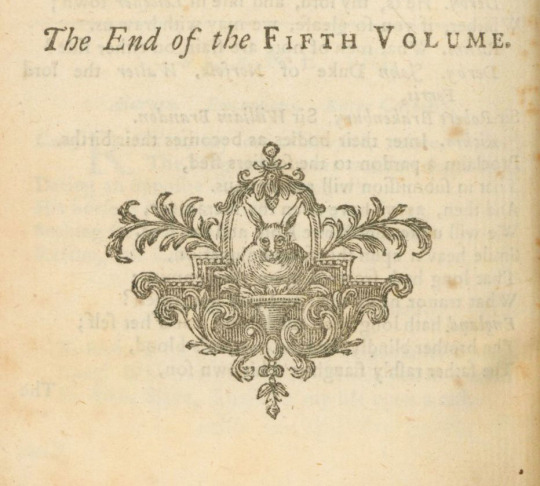
-Jenna, Special Collections Graduate Intern
#william shakespeare#shakespeare#alexander pope#dr. george sewell#jacob tonson#tetralogy#King Henry VI Part I#King Henry VI Part II#King Henry VI Part III#King Richard III#louis du guernier#paul fourdrinier#shakespeare weekend#engravings
19 notes
·
View notes
Text
Strength of a High and Noble Hill (Outlander Story) - Masterlist

Timelines:
19th and 20th Centuries
17th and 18th Centuries
Fraser Descendants (family tree)
Warnings:
Major Character Death, Minor Character Death, Period-Typical Homophobia, Period Typical Attitudes, Period-Typical Sexism, Period-Typical Racism, Implied/Referenced Rape/Non-con
Summary:
May 1744
He wriggles his toes, feeling his environment. He quickly realises how much his surroundings are constricted, his legs are tightly bound and he is being cradled in someone’s arms. He opens his eyes and sees a woman leaning over him and realises she must be the one holding them. She’s humming softly with a warm and happy smile. He can see that her skin is clammy and there are bruises under her eyes, the eyes that are amber, golden-brown as well as smoky topaz, but that doesn’t dim her smile as she gazes upon the person in her arms. She’s white and her brown hair surrounds her face in messy curls.
——
What if Claire and Jamie’s first baby survived and what if it had been a boy. How will the story change?
Chapters:
Chapter 1: Birth
Chapter 2: First Months
Chapter 3: Peaceful Family Life Disrupted
Chapter 4: Goodbyes
Chapter 5: New Beginnings
Chapter 6: A Fish Out of Water
Chapter 7: Conflict
Chapter 8: Sister
Chapter 9: Returning
Chapter 10: The Truth
Chapter 11: The Loss of Hope
Chapter 12: Coping with Change
Chapter 13: Finding Him
Chapter 14: Moving to the Past
Chapter 15: Loss
Chapter 16: Lost Family
Chapter 17: A New but Old World
Chapter 18: Reunited at Last
Chapter 19: Big Brother
Chapter 20: Coming Together
Chapter 21: Fathers
Chapter 22: Dreams
Chapter 23: Fathers and Their Archaic Ways
Chapter 24: River Run
Chapter 25: A New but Old Face
Chapter 26: Caught in the Act
Chapter 27: Family Time
Chapter 28: New Beginnings
Chapter 29: Waiting
Chapter 30: Old Dreams
Chapter 31: Inferiority Complex
Chapter 32: Community Swelling
Chapter 33: Purpose
Chapter 34: First Sight
Chapter 35: Is it Happily Ever After?
Chapter 36: Gifts and Awkward Conversations
Chapter 37: Unravels
Chapter 38: Lay Up Trouble For Yourself
Chapter 39: War Wins Land, Peace Wins People
Chapter 40: Life Goes On But The Threat Looms
Chapter 41: Building Arsenal
Chapter 42: Romeo and Juliet
Chapter 43: Baggage Weighs You Down
Chapter 44: Misunderstandings
Chapter 45: Should auld acquaintance be forgot?
Chapter 46: Jesus H. Roosevelt Christ
Chapter 47: Best Not To Tell
Wattpad access
fanfiction.net access
Ao3 access
#outlander#original male character#original female character#faith lives (sort of)#oc x oc#bisexual#jamie fraser#claire fraser#fergus fraser#marsali fraser#brianna fraser#roger mackenzie#ian murray#time travel#implied/referenced character death#implied/referenced child abuse#tw: implied/referenced rape/noncon#cannon divergence#cannon typical violence#period typical homophobia#period typical racism#period typical sexism#reincarnation
4 notes
·
View notes
Text
How many naval ships bore the name Victory?
There were six other ships that bore the same name. The first was a merchant ship called Christopher, which was taken into the navy in 1560 and renamed Victory. In 1586 she was rebuilt and listed as a ship with an armament of twelve 18-pdr. nine 6-pdr. and twenty smaller guns. When she fought the Spanish Armada in 1588, her crew consisted of 300 sailors, 34 gunners and 400 soldiers. In 1608 she was wrecked.
The second Victory was a 42-gun ship designed by Phineas Pett and built at Deptford in 1620.

HMS Victory of 1620, by Willem van de Velde, c. 1655 (x)
In 1666 she was converted at Chatham into a second rate ship of 82 guns. During her service she fought the Dutch off Dover in 1652, Portland, Gabbard and Scheveningen in 1653, Orfordness in 1666, Solebay in 1672 and Texel in 1673. She also fought the French at Barfleur in 1692. This ship was wrecked at Woolwich in 1691.
The third ship, the Little Victory, a fifth ship of 28 guns, was built at Chatham in 1665 and decommissioned as a fireboat in 1671. The fourth ship, the Victoire, a fifth rate ship of 38 guns, was captured by the French on 5 April 1666 and by the Dutch in 1672.
The fifth ship was a 100-gun first class ship laid down at Portsmouth on 23 February 1726 and launched on 23 February 1737. The origins of this Victory are notable as she was technically a conversion using the frames of the Royal James which had been built in 1675. The Royal James was renamed Victory in 1691, converted to Chatham in 1695, renamed Royal George on 27 October 1714 and renamed Victory again in September 1715. Unfortunately, the ship burnt down in an accident in 1721 and was dismantled in April of the same year. The wooden parts were used for the Victory, which was launched in 1737 but sank in the Channel in 1744 in a heavy storm.

Loss of HMS Victory, 4 October 1744, by Peter Monamy (1681- 1749) (x)
The Victory, which still exists today, is the sixth ship of the Royal Navy and was planned in 1759 as part of the "Year of Victories" and designed by Sir Thomas Slade.

The Battle of Trafalgar, by J. M. W. Turner (1775- 1851) (x)
The plan was based on that of the Royal George of 1756. After some difficulties, the Victory was launched in 1765.
The last ship with this name was a small schooner with 8 guns, serving in Canada. She was launched in 1764, one year before the Victory that still exists today. She was not in service for long, however, because 4 years later she was probably burnt by the French.
60 notes
·
View notes
Text
Introduction
Lysenkoism was a pseudoscientific belief system associated with Soviet plant breeder Trofim Denisovich Lysenko (1898–1976). Lysenko rejected nearly a century of advances in genetics, the study of inherited characteristics in living things. His influence on science and agriculture in the Soviet Union in the 1930s through the early 1950s illustrates the disastrous consequences that may ensue when politics and ideology interfere with science. Lysenkoism became the Soviet government's official program and had major effects on government policies. It worsened food shortages in the Soviet Union, and real scientists were imprisoned for disagreeing with it. Some were killed.
Historical Background and Scientific Foundations
Ten years after Russia's 1917 revolution, which led to the formation of the Union of Soviet Socialist Republics (USSR), a plant breeder named Trofim Denisovich Lysenko observed that pea seeds germinated faster when maintained at low temperatures. Instead of reasoning that the plant's ability to respond flexibly to temperature variations was a natural characteristic—as further testing would have confirmed—Lysenko erroneously concluded that low temperatures forced seeds to alter their inherited characteristics.
Lysenko's erroneous conclusions were influenced by the teachings of Russian horticulturist I.V. Michurin (1855–1935), a holdover proponent of the Larmarckian theory of evolution by inheritance of acquired characteristics (the belief that species can evolve by individuals acquiring traits during their lifetime and then passing them on to offspring). Lamarckism had, at one time, been a legitimate scientific theory. In the late eighteenth and early nineteenth century, French anatomist Jean-Baptiste Lamarck (1744–1829) attempted to explain such adaptations as the long necks of giraffes by arguing that a giraffe, by stretching its neck to get leaves on high tree branches, actually made its neck lengthen, and that this individual would pass a longer neck on to its offspring. Thus, according to Lamarck, the extremely long necks of modern giraffes were the result of generation after generation of giraffes stretching their necks to reach higher for food. The evidence for Lamarckian evolution was once thought convincing: Even English naturalist Charles Darwin (1809–1882), discoverer of the real source of adaptive evolution (natural selection of random variations in inherited characteristics), taught that Lamarck's mechanism contributed to evolution.
Unfortunately for Lysenko and Soviet science, Lamarck's theory of evolution by the inheritance of acquired characteristics was incorrect. By the beginning of the twentieth century, scientists had already discarded Lamarckian evolution in favor of Darwin's concept of natural selection. Today, we know that the inheritable aspects of traits are determined by long, ladder-like molecules of DNA (deoxyribonucleic acid) found in the nucleus of almost every cell. These molecules of inheritance are not influenced by the use, disuse, or even loss of body parts. Darwinian natural selection explains the long necks of giraffes as the result of the greater feeding success, over many generations, of giraffes who happened, thanks to random changes in DNA, to have longer necks. Giraffes who, by chance, had shorter necks or other unfavorable characteristics have not left any offspring.
Despite the fact that Lamarck's theory of evolution by inheritance of acquired characteristics had already been widely discarded as a scientific hypothesis in the early twentieth century, a remarkable set of circumstances gave Lysenko the opportunity to sweep aside more than a hundred years of scientific investigation and advocate his own schemes for enhancing agricultural production. When Lysenko promised greater crop yields to government officials, a Soviet Central Committee, desperate to increase food production after famine in the early 1930s, listened with an attentive ear. Lysenko claimed that the spirit of Marxist theory (on which the Soviet Union was based) called for a theory of species formation which would entail “revolutionary leaps.” Lysenko attacked Mendelian genetics and Darwinian evolution as a theory of “gradualism.”
Lysenko constructed an elaborate hypothesis that came to be known as the theory of phasic development. One of Lysenko's ideas was to “toughen” seeds by treating them with heat and high humidity to increase their ability to germinate under harsh conditions. The desire to plant winter instead of spring forms of wheat was heightened by the need to expand Russian wheat production into areas climatically colder than traditional growing areas. The Nazi invasion during the Second World War made it critical to plant in colder, previously fallow eastern regions as the USSR was deprived of its Ukrainian breadbasket by Hitler's onslaught.
Faced with famine, Soviet agricultural planners became unconcerned with long-term scientific studies, making them vulnerable to Lysenko's unfounded claims. They believed what they wanted to believe, and looked no further into the validity of Lysenko's claims.
Lysenko ruled virtually supreme in Soviet science for years, extending his influence beyond agriculture to other areas of science. In 1940, Soviet dictator Joseph Stalin (1922–1953) appointed Lysenko Director of the Soviet Academy of Science's Institute of Genetics. In 1948, the Praesidium of the USSR Academy of Science passed a resolution virtually outlawing any biological work not based on Lysenko's ideas.
Although thousands of experiments carried out by geneticists all over the world failed to provide evidence for Lysenko's notions of transmutation of species—indeed, produced vast amounts of evidence against it—Lysenko's followers made increasingly grandiose claims regarding crop yields and the transformation of species. Not until 1953, following the death of Stalin, did the Soviet government publicity acknowledge that Soviet agriculture had failed to meet economic plan goals and thereby provide the food needed by the Soviet State.
The Lysenkoist episode reversed a longstanding tradition of Russian scientific progress. Despite the near-medieval conditions in which most of the population of Czarist Russia lived, the scientific achievements of pre-revolutionary Russia rivaled those of Europe and America. In fact, achievement in science had been one of the few avenues to wealth open to the non-nobility. The revolution had sought to maintain this tradition and win over the leaders of Russian science. From the earliest days, revolutionary leaders Lenin and Trotsky fought, even in the midst of famine and civil war, to make resources available for scientific research.
In the political storms that ravaged the Soviet Union following the rise of Stalin, including mass executions of dissidents and engineered famines in the Ukraine that killed millions, Lysenko's idea that all organisms, given the proper conditions, have the capacity to be or do anything seemed to have certain attractive parallels with the social philosophies of Karl Marx (and the twentieth century French philosopher Henri Bergson), who promoted the idea that man was largely a product of his own will. Enamored for ideological reasons with Lysenko's pseudoscientific claims, Stalin took matters one step further by personally attacking modern genetics as “counter-revolutionary” or “bourgeois” science. (“Bourgeois” is a French word meaning upper- and middle-class; in Soviet jargon, it was equivalent to “enemy of the revolution.”) While the rest of the scientific community knew that evolution could not be understood without Mendelian genetics, Stalin used violence and political power to suppress scientific inquiry. Under Stalin, science was made to serve political ideology: Scientists were required to say the things that those in power wanted them to say, regardless of physical reality.
The victory of Stalin's faction within the ruling party changed the previously nurturing relationship between the Soviet State and science. Important developments in science (including what we would term today the social sciences) were terminated by state terror. During the 1930s and 1940s, scientists were routinely executed, imprisoned, or exiled. Soviet science was largely carried forward in specially-built labor camps, where scientists denounced publicly as “saboteurs” continued their work in isolation from the outside world.
Information on genetics was eliminated from Soviet biology textbooks as Lysenko attempted to reduce his conflict with classical geneticists to politics. He stated that there existed two class-based biologies: “bourgeois” (bad) and “socialist, dialectical materialist” (good). The entire agricultural research infrastructure of the Soviet Union—a country where millions teetered on the edge of starvation—was devoted to a disproved scientific hypothesis, and inventive methods were used to falsely “prove” that there was no famine and that crop yields were actually on the rise.
Soviet Central Committee support of Lysenko was critical to his success. It was known that Stalin clearly expressed his positive attitude toward the idea of the inheritance of acquired characteristics and his overall support of Lamarckism; in such an atmosphere, some of Lysenko's supporters even denied the existence of chromosomes (dark objects in cell nuclei containing heritable material; it was not known until the 1950s that this material is the molecule DNA). Genes were denounced as “bourgeois constructs.” Under Lysenko, Mendelian genetics was branded “decadent,” and scientists who rejected Lamarckism in favor of natural selection became “enemies of the Soviet people.”
Some scientists resisted. Soviet geneticist Nikolay Ivanovich Vavilov (1887–1943) tried to expose Lysenko's claims as pseudoscientific. As a result, Vavilov was arrested in August 1940 and later died in a prison camp. Throughout Lysenko's reign there were widespread arrests of geneticists, who were denounced as “agents of international fascism.” In fear for their lives, many Soviet scientists submitted. Some presented fraudulent data to support Lysenko, others destroyed evidence showing that he was wrong. Letters by scientists who had once advanced Mendelian genetics were made public in which they confessed the errors of their ways and extolled the wisdom of the Party.
Lysenko falsely predicted greater crop yields through hardening of seeds and a new system of crop rotation. His crop rotation method eventually led to soil depletion that required years of replenishment with mineral fertilizers. Under Lysenko's direction, hybrid corn programs based on successful U.S. models were ended and the research facilities destroyed because Lysenko opposed what he termed “inbreeding.”
When Nikita Khrushchev (1894–1971) assumed the post of Soviet Premier following the death of Stalin in 1953, opposition to Lysenko began slowly to grow. Khrushchev eventually stated that under Lysenko “Soviet agricultural research spent over 30 years in darkness.” In 1964, Lysenko's doctrines were officially discredited, and intensive efforts were made toward reestablishing Mendelian genetics and bringing Soviet agriculture, biology, and genetics into conformity with Western nations.
==
Lysenokism is what happens when objective reality is denied in order to prop up a political, ideological narrative.
Say what's true. Reality will not tolerate otherwise.
#Lysenkoism#Trofim Lysenko#antiscience#anti science#science denial#science deniers#objective reality#pseudoscience#ideological corruption#science vs pseudoscience#pseudoscience vs science#Soviet famine#religion is a mental illness
11 notes
·
View notes
Text
bring me peace in your oblivion
by bleepbloopbee
The statue of Achilles mocks him. It looms above him, a permanent reminder of the love torn away from him.
“Where are you, my Achilles?” he asks the air.
He bows his head, looking down at the armor he wears. Armor that is not his own. He knows every crevice of the metal by now. Already knew it well in life, with how much time he spent dressing and undressing the man who wore this set. He knows it better now, after spending eons looking down at himself to try to remember how it felt to undo the straps and touch the warm skin below.
“You are somewhere else,” he sighs. “I wish I knew where, or even why.”
He traces the line of his bracer with his other thumb, the metal cool to the touch.
“Return to me, and wear this armor again…”
even though he had no use of it anymore. It is his.
Patroclus sighs again, running his thumb over the metal over and over and over and over and over again.
Patroclus waits lifetimes for his love to return. The pain grows and grows and grows, the weight of his mortal life and all those mistakes within it becoming difficult to carry. He holds out best he can, but Achilles does not return in time to stop him from succumbing.
Words: 1744, Chapters: 1/?, Language: English
Fandoms: Hades (Video Game 2018)
Rating: Mature
Warnings: Creator Chose Not To Use Archive Warnings
Categories: M/M
Characters: Achilles (Hades Video Game), Patroclus (Hades Video Game), Zagreus (Hades Video Game)
Relationships: Achilles/Patroclus (Hades Video Game)
Additional Tags: Alternate Universe - Canon Divergence, Reunions, Angst, Bittersweet Ending, Hurt/Comfort, Hurt No Comfort, at least no comfort for a very long time, Memory Loss, Blood and Injury, Mentions of Violence, Post-Traumatic Stress Disorder - PTSD, Guilt, Drinking from the Lethe, Additional Warnings In Author's Note, Other Additional Tags to Be Added
source https://archiveofourown.org/works/41338839
1 note
·
View note
Text
The End Is Just the Beginning
https://ift.tt/YtREjHy
by Anonymous
Elim Garak was dead and Julian Bashir no longer wanted to live.
But Rom and Leeta know that Julian's death would be a great loss to The Great Material Continuum - and themselves - so they journey to Cardassia to bring Julian home.
Words: 1744, Chapters: 1/1, Language: English
Fandoms: Star Trek: Deep Space Nine
Rating: Teen And Up Audiences
Warnings: Major Character Death
Categories: M/M, Multi
Characters: Julian Bashir, Leeta (Star Trek), Rom (Star Trek), Elim Garak, Ghost Elim Garak
Relationships: Julian Bashir/Leeta/Rom, Bashir & Leeta & Rom, Julian Bashir/Elim Garak, Julian Bashir & Elim Garak, Julian Bashir & Ghost Elim Garak
Additional Tags: Lovers to Friends, Friends to Lovers, Ghosts, Trick or Treat: Trick, Polyamory, Post-Canon, Post-Canon Cardassia, Ferenginar, Cardassia, Post-Canon Ferenginar, Paranormal, Supernatural Elements, Julian Bashir and Elim Garak's Book Club, continues in the Afterlife
0 notes
Text
Day 6
I am really proud of myself today. It's been about a week and it was time to check in on my fat loss process. I lost 1.3% of by body fat! (Or 3ish fat pounds) I say it all this way because what I am trying to avoid is to get caught up on what the scale says. (The scale said I lost a pound and a half basically)
I could get way into it, but my main goals for "losing weight" have actually nothing to do with losing weight. I am interested in fat loss so that I can be at a healthy place for my body shape and height and I also want to build as much muscle as I can. What this means is that I lift weights and follow a "macro" style approach to eating. One of these days I'll get more into what that really looks like for me, but if anyone is interested, you can learn a lot by going to iifym.com It's a style of eating that encourages you to eat as many calories as you can based on your metabolism and lifestyle (most people don't eat enough), eat sufficient protein (most of us don't get enough), and then essentially eat whatever you want so long "as it fits your macros".
"Macros" just mean protein, carbs, and fat. Right now I am on 123g protein, 172g carbs, and 63g fat. That equals 1744 calories per day, which seemed like a lot when I first heard it. Oh, diet culture. So damaging for people. Oh, and also you are supposed to engage in cardio pretty minimally, unlike common belief. Now, if you were someone who loved cardio and that was already a part of your lifestyle you could totally still keep up with it, you would just have to eat more calories. Really it's all about learning to eat a more balanced diet and make sure you are getting enough of the important stuff and less of the stuff that puts on weight. So let me reiterate... this last week I did 15 min of cardio, ate over 1700 calories a day, did not have a super active week, and still lost 1.3% of my bodyweight. It's pretty awesome. I never once felt hungry or deprived or like... oh my gosh this is hard. This means at this level, it's sustainable. (My goal later is to get above 2000 calories and be able to maintain my new, healthier body composition. But that's later.)
Now I am all about body positivity and to be honest... I think we all, myself especially included, have a tendency to put too much emphasis on "thinness". I totally think that you should love your body as it is at any stage. But, for me, I also want to maintain a level of fitness and body composition that lies within the range that science has said means you are less likely to have health problems. I'm 37 and almost 200 pounds. I really feel like it's in my best interest to engage in this fitness journey. For me, for my kids, and for my future. I also don't have an eating disorder or any history of surgery or anything like that so I am only speaking for myself. I know things are different for everyone!
That said, I am so proud of myself for a) doing something I said I was going to do and b) putting the work in to see some positive results. This is an example of self-love for me. :)
0 notes
Text
Events 7.4
362 BC – Battle of Mantinea: The Thebans, led by Epaminondas, defeated the Spartans.
414 – Emperor Theodosius II, age 13, yields power to his older sister Aelia Pulcheria, who reigned as regent and proclaimed herself empress (Augusta) of the Eastern Roman Empire.
836 – Pactum Sicardi, a peace treaty between the Principality of Benevento and the Duchy of Naples, is signed.
993 – Ulrich of Augsburg is canonized as a saint.
1054 – A supernova, called SN 1054, is seen by Chinese Song dynasty, Arab, and possibly Amerindian observers near the star Zeta Tauri. For several months it remains bright enough to be seen during the day. Its remnants form the Crab Nebula.
1120 – Jordan II of Capua is anointed as prince after his infant nephew's death.
1187 – The Crusades: Battle of Hattin: Saladin defeats Guy of Lusignan, King of Jerusalem.
1253 – Battle of West-Capelle: John I of Avesnes defeats Guy of Dampierre.
1359 – Francesco II Ordelaffi of Forlì surrenders to the Papal commander Gil de Albornoz.
1456 – Ottoman–Hungarian wars: The Siege of Nándorfehérvár (Belgrade) begins.
1534 – Christian III is elected King of Denmark and Norway in the town of Rye.
1584 – Philip Amadas and Arthur Barlowe arrive at Roanoke Island
1610 – The Battle of Klushino is fought between forces of the Polish–Lithuanian Commonwealth and Russia during the Polish–Muscovite War.
1634 – The city of Trois-Rivières is founded in New France (now Quebec, Canada).
1744 – The Treaty of Lancaster, in which the Iroquois cede lands between the Allegheny Mountains and the Ohio River to the British colonies, was signed in Lancaster, Pennsylvania.
1774 – Orangetown Resolutions are adopted in the Province of New York, one of many protests against the British Parliament's Coercive Acts.
1776 – American Revolution: The United States Declaration of Independence is adopted by the Second Continental Congress.
1778 – American Revolutionary War: U.S. forces under George Clark capture Kaskaskia during the Illinois campaign.
1802 – At West Point, New York, the United States Military Academy opens.
1803 – The Louisiana Purchase is announced to the American people.
1817 – In Rome, New York, construction on the Erie Canal begins.
1818 – US Flag Act of 1818 goes into effect creating a 13 stripe flag with a star for each state. New stars would be added on 4th of July after a new state had been admitted.
1827 – Slavery is abolished in the State of New York.
1831 – Samuel Francis Smith writes "My Country, 'Tis of Thee" for the Boston, Massachusetts July 4 festivities.
1832 – John Neal delivers the first public lecture in the US to advocate the rights of women.
1832 – Durham University established by Act of Parliament; the first recognized university to be founded in England since Cambridge over 600 years earlier.
1837 – Grand Junction Railway, the world's first long-distance railway, opens between Birmingham and Liverpool.
1838 – The Iowa Territory is organized.
1845 – Henry David Thoreau moves into a small cabin on Walden Pond in Concord, Massachusetts. Thoreau's account of his two years there, Walden, will become a touchstone of the environmental movement.
1855 – The first edition of Walt Whitman's book of poems, Leaves of Grass, is published in Brooklyn.
1862 – Lewis Carroll tells Alice Liddell a story that would grow into Alice's Adventures in Wonderland and its sequels.
1863 – American Civil War: Siege of Vicksburg: Vicksburg, Mississippi surrenders to U.S. forces under Ulysses S. Grant after 47 days of siege.
1863 – American Civil War: Union forces repulse a Confederate army at the Battle of Helena in Arkansas. The Confederate loss fails to relieve pressure on the besieged city of Vicksburg, and paves the way for the Union to capture Little Rock.
1863 – American Civil War: The Army of Northern Virginia withdraws from the battlefield after losing the Battle of Gettysburg, signalling an end to the Confederate invasion of U.S. territory.
1879 – Anglo-Zulu War: The Zululand capital of Ulundi is captured by British troops and burned to the ground, ending the war and forcing King Cetshwayo to flee.
1881 – In Alabama, the Tuskegee Institute opens.
1886 – The Canadian Pacific Railway's first scheduled train from Montreal arrives in Port Moody on the Pacific coast, after six days of travel.
1887 – The founder of Pakistan, Quaid-i-Azam Muhammad Ali Jinnah, joins Sindh-Madrasa-tul-Islam, Karachi.
1892 – Western Samoa changes the International Date Line, causing Monday (July 4) to occur twice, resulting in a year with 367 days.
1894 – The short-lived Republic of Hawaii is proclaimed by Sanford B. Dole.
1898 – En route from New York to Le Havre, the SS La Bourgogne collides with another ship and sinks off the coast of Sable Island, with the loss of 549 lives.
1901 – William Howard Taft becomes American governor of the Philippines.
1903 – The Philippine–American War is officially concluded.
1910 – The Johnson–Jeffries riots occur after African-American boxer Jack Johnson knocks out white boxer Jim Jeffries in the 15th round. Between 11 and 26 people are killed and hundreds more injured.
1911 – A massive heat wave strikes the northeastern United States, killing 380 people in eleven days and breaking temperature records in several cities.
1913 – President Woodrow Wilson addresses American Civil War veterans at the Great Reunion of 1913.
1914 – The funeral of Archduke Franz Ferdinand and his wife Sophie takes place in Vienna, six days after their assassinations in Sarajevo.
1918 – Mehmed V died at the age of 73 and Ottoman sultan Mehmed VI ascends to the throne.
1918 – World War I: The Battle of Hamel, a successful attack by the Australian Corps against German positions near the town of Le Hamel on the Western Front.
1927 – First flight of the Lockheed Vega.
1939 – Lou Gehrig, recently diagnosed with Amyotrophic lateral sclerosis, informs a crowd at Yankee Stadium that he considers himself "The luckiest man on the face of the earth", then announces his retirement from major league baseball.
1941 – Nazi crimes against the Polish nation: Nazi troops massacre Polish scientists and writers in the captured Ukrainian city of Lviv.
1941 – World War II: The Burning of the Riga synagogues: The Great Choral Synagogue in German-occupied Riga is burnt with 300 Jews locked in the basement.
1942 – World War II: The 250-day Siege of Sevastopol in the Crimea ends when the city falls to Axis forces.
1943 – World War II: The Battle of Kursk, the largest full-scale battle in history and the world's largest tank battle, begins in the village of Prokhorovka.
1943 – World War II: In Gibraltar, a Royal Air Force B-24 Liberator bomber crashes into the sea in an apparent accident moments after takeoff, killing sixteen passengers on board, including general Władysław Sikorski, the commander-in-chief of the Polish Army and the Prime Minister of the Polish government-in-exile; only the pilot survives.
1946 – The Kielce pogrom against Jewish Holocaust survivors in Poland.
1946 – After 381 years of near-continuous colonial rule by various powers, the Philippines attains full independence from the United States.
1947 – The "Indian Independence Bill" is presented before the British House of Commons, proposing the independence of the Provinces of British India into two sovereign countries: India and Pakistan.
1950 – Cold War: Radio Free Europe first broadcasts.
1951 – Cold War: A court in Czechoslovakia sentences American journalist William N. Oatis to ten years in prison on charges of espionage.
1951 – William Shockley announces the invention of the junction transistor.
1954 – Rationing ends in the United Kingdom.
1960 – Due to the post-Independence Day admission of Hawaii as the 50th U.S. state on August 21, 1959, the 50-star flag of the United States debuts in Philadelphia, almost ten and a half months later (see Flag Acts (United States)).
1961 – On its maiden voyage, the Soviet nuclear-powered submarine K-19 suffers a complete loss of coolant to its reactor. The crew are able to effect repairs, but 22 of them die of radiation poisoning over the following two years.
1966 – U.S. President Lyndon B. Johnson signs the Freedom of Information Act into United States law. The act went into effect the next year.
1976 – Israeli commandos raid Entebbe airport in Uganda, rescuing all but four of the passengers and crew of an Air France jetliner seized by Palestinian terrorists.
1976 – The U.S. celebrates its Bicentennial.
1977 – The George Jackson Brigade plants a bomb at the main power substation for the Washington state capitol in Olympia, in solidarity with a prison strike at the Walla Walla State Penitentiary Intensive Security Unit.
1982 – Three Iranian diplomats and a journalist are kidnapped in Lebanon by Phalange forces, and their fate remains unknown.
1987 – In France, former Gestapo chief Klaus Barbie (a.k.a. the "Butcher of Lyon") is convicted of crimes against humanity and sentenced to life imprisonment.
1994 – Rwandan genocide: Kigali, the Rwandan capital, is captured by the Rwandan Patriotic Front, ending the genocide in the city.
1997 – NASA's Pathfinder space probe lands on the surface of Mars.
1998 – Japan launches the Nozomi probe to Mars, joining the United States and Russia as a space exploring nation.
2001 – Vladivostock Air Flight 352 crashes on approach to Irkutsk Airport killing all 145 people on board.[4]
2002 – A Boeing 707 crashes near Bangui M'Poko International Airport in Bangui, Central African Republic, killing 28.
2004 – The cornerstone of the Freedom Tower is laid on the World Trade Center site in New York City.
2004 – Greece beats Portugal in the UEFA Euro 2004 Final and becomes European Champion for first time in its history.
2005 – The Deep Impact collider hits the comet Tempel 1.
2006 – Space Shuttle program: Discovery launches STS-121 to the International Space Station. The event gained wide media attention as it was the only shuttle launch in the program's history to occur on the United States' Independence Day.
2009 – The Statue of Liberty's crown reopens to the public after eight years of closure due to security concerns following the September 11 attacks.
2009 – The first of four days of bombings begins on the southern Philippine island group of Mindanao.
2012 – The discovery of particles consistent with the Higgs boson at the Large Hadron Collider is announced at CERN.
2015 – Chile claims its first title in international football by defeating Argentina in the 2015 Copa América Final.
0 notes
Text
What You Need to Know About Sotheby's
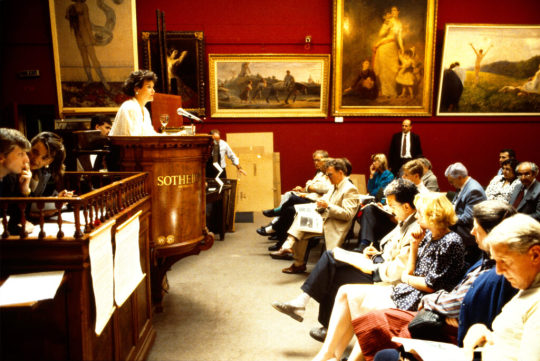
Sothebys is an American multinational company established by a British family. The business is just one of the world's leading brokers of fine art, jewelry, as well as antiques. It runs from 80 places in 40 countries, including London as well as New York City, and also maintains a significant visibility in the UK. This short article will discover a few of the important points to know about the firm. Nonetheless, it is not meant to be a comprehensive guide to all points Sothebys. In the late 1970s, the company was having a hard time economically. The Sotheby’s website supplies a substantial collection of art by famous musicians.
Although it boasted a low two-figure workforce, the company administration design was relatively loose as well as undemanding. Without Wilson's leadership, losses quickly accumulated. At the time, the business faced hazards from 2 American entrepreneurs, and also the British Parliament intervened to avoid a hostile takeover. After all, Sotheby's was already dealing with a decline when Wilson left. The business has actually broadened its services recently in order to attract brand-new types of collection agencies. Because of this, it has arranged numerous "theme" sales, including public auctions of Arabian equines, sporting activities pictures, and guns.
In addition to its auctions, Sotheby's additionally has services associated with storage as well as evaluation. Thus, the company has a global footprint. While its background is fascinating, it is unlikely to be completion of the tale. Sotheby's is a global business, and has various branches and also departments. Sotheby's initial acquisition was available in the early 1900s. It became part of a team of Stylist masters. A well-known one, the 1957 Weinberg Collection, was sold for PS220,000. The salesclerk Peter Wilson asked after the sale, "Will no one quote for this painting? Will no person proposal much more?". When offering an item, a seller needs to send a Public auction Estimate Type, that includes thorough details and a photo of the thing. The seller after that authorizes a contract with Sothebys, establishing a book price and a commission for the firm. This industry is a wonderful location to buy original art due to the fact that the website pays 97% of the sales price to the artist.
As soon as the item is sold, the purchaser is expected to pay a premium that is equal to 10% of the hammer rate. In this manner, Sothebys makes certain the highest rate for its clients. As an international auction house, Sotheby's has actually expanded to turn into one of the biggest worldwide. With over 80 areas around the globe, the firm has expanded to include retail sales, collectibles, as well as art advisory solutions. Their internet site likewise offers a durable digital engagement platform for customers. There's no much better time to purchase an artwork, than now. Sothebys's New York City headquarters is a spots in the art world. The company's history can be mapped to Samuel Baker, a bookseller who began the firm in London in 1744. His first auction, entitled Numerous Hundred Rare as well as Valuable Books in All Branches of Polite Literature, gained PS826 in London. His descendants expanded the business and also remained there for over 80 years. They eventually transferred to 13 Wellington Street. They eventually began marketing books of Napoleon's banished relative.
Here is a post with a general information about this topic, check it out: https://en.wikipedia.org/wiki/Work_of_art.
0 notes
Photo
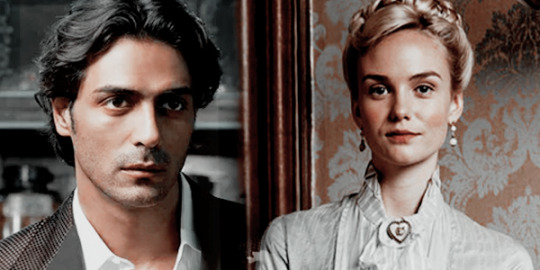

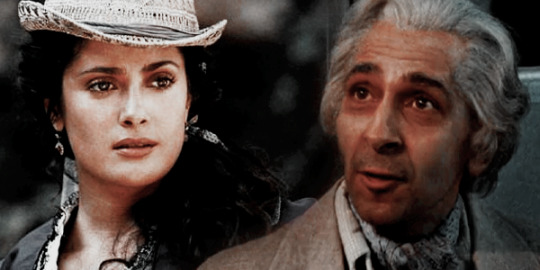
TASK 004 → FAMILY TIES
BARON CHARLES MATTHEW MERCHANT (b. 1770) - older brother
Heir to the Merchant estate, Charles is clever and kind, albeit rather stiff. Dedicated and duty-driven, Charles loves his sister although he finds her rather impossible on most days. He cares for his sister deeply, but with his new marriage, he finds it difficult to keep the peace between Aurelia and his wife. Despite his lack of strong social skills, Charles is rather adept with finances and has grown the Merchant fortune significantly since taking over the household.
BARONESS LYDIA JANE MERCHANT née BELLMORE (b. 1774) - sister-in-law
A former childhood friend, Lydia was once a rather lively and warm individual, but has since grown cruel and unrelenting with age. With a penchant for properness and rules, Lydia is rather off-put by Aurelia’s more rebellious history, her dislike only amplified by their shared, messy history. Growing up alongside the Merchant, Lydia and Charles had always been fond of one another. After Lydia’s engagement to a Marquess broke off due to reasons that may or may not involve Aurelia, Lydia and Charles began a courtship that would result in marriage.
LADY EVANNA TERESA MERCHANT née FONSECA (b. 1752) - mother
Evanna Fonseca was a silent firecracker, unlike any other, though settling down had cooled those fiery flames. Truthfully, Evanna had never wanted children. She loved them, yes, but children had always been something of an obligation, more than a desire. Thus, when her youngest passed away, she took mourning as an excuse to retreat even farther away from her family and the duties of motherhood, embracing the more solitary lifestyle she had always longed for.
LORD EDWARD ARTHUR MERCHANT (b. 1744) - father
Edward Merchant had never wanted the duties that came with inheriting the Merchant title. An emotional man, Edward had always been quick to follow his heart. His heart would lead him to Evanna, whom he would have three darling children with. Edward doted on all of his children and the loss of Oliver crushed his soul and spirit to the point of no return. Like his wife, he has retreated from society, nursing a broken heart that will never be whole again.
OLIVER EDWARD MERCHANT (b. 1776 - d. 1790) - younger brother
Oliver, the youngest Merchant, was the adventurous spirit that glued the Merchant family together. Calm, with a youthful glow about him, Oliver was capable of diffusing the fiercest arguments. Beloved by his family and friends, his premature death, as a result of accidental drowning, sent shockwaves through the Merchant family, which never quite recovered from his passing.
5 notes
·
View notes
Photo
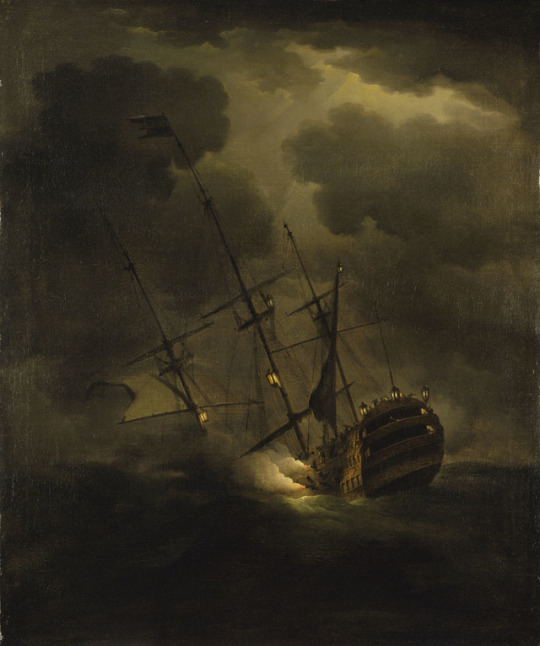
Loss of the Victory 4 October 1744 ,by Peter Monamy 18th century
The keel laying of the Victory took place on 6 March 1726 in Portsmouth. The ship was built by master shipbuilder Joseph Allin and was initially to cost £38,239 - plus a further £12,652 for further adaptations as a flagship.
The Victory had three decks and had a smooth transom in the stern area. Galleries were integrated into the transom, which led to the side galleries on the sides and were open for the first time in the Royal Navy as a shipbuilding novelty. As a special feature, the Victory also had a gallery construction on the upper poop deck (Poop-Royal), so that it had four rows of windows, four rows of lights and three open galleries at the stern, which were decorated with numerous baroque carvings.
Due to its powerful appearance, contemporaries attributed to it a military deterrent function that should not be underestimated.At the uppermost position of the stern there were traditionally three stern lanterns.
It is very likely that of the predecessor Victory, originally called Royal James and renamed Victory in 1691, which was destroyed by fire in 1721 during repair work, some woods were also used in this new Victory, especially as it was officially considered a rebuilt of the ship which was burnt during calfater work and subsequently dismantled.The new Victory was equipped with 100 cannons and was therefore a first rate. She was also the last 1st class ship of the Royal Navy to be completely equipped with bronze cannons. She was also the only Royal Navy ship to have the unusual number of 15 ports per side on the upper gun deck.
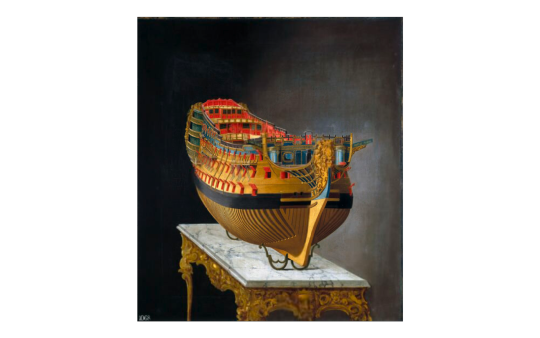
After 11 years of construction in dry dock, it was launched at the Royal Dockyards of Portsmouth on 23 February 1737 and placed under the Channel Fleet of Admiral Sir John Norris in 1739. Thomas Whitney became captain of the ship.Admiral Norris followed on 16 July 1739 provocations of the Spanish fleet and Spanish buccaneers and left with 16 ships, in order to fight the Spaniards finally and to prevent further influences on British ship movements. Although there were no major battles, Norris apparently managed a successful intervention.
On 16 July 1740 the Victory collided with the Lion and lost the bowsprit.In March 1744 King George II granted Norris retirement after 54 years of service.In July 1744 Admiral Sir John Balchen, who was at that time second highest commander of the Royal Navy, took over the Victory as flagship; Captain was Samuel Faulkner since December 1741 already, who replaced the deceased Whitney.
As Balchen’s flagship at the time, the Victory did not take part in any major naval battles of its time, but was mainly used to protect the important trade routes and thus to maintain or expand the extraordinary trading position of the British by providing escort for merchant ships or helping hijacked convoys. The Victory was ordered in 1744 in a strong squadron of 8 Dutch and 25 British ships as the flagship of Admiral Balchen to the Tajo River Delta, after the French Brest fleet had established a large convoy of British merchant ships there.Balchen managed to beat the French into flight so that he could accompany the convoy all the way to Gibraltar. He then attempted to capture parts of the French fleet and engage them in battle. On 9 August 1744 Balchen was able to take eleven large merchant ships from San Domingo as prizes. On 9 September 1744, while he was besieging the port of Cádiz, the commander of his Dutch ships under his command, Admiral Hendrik Gravé, informed him that water and food for his ships were scarce and that they had to be replenished.
Balchen then ordered the return journey to England in order to pick up provisions, carry out repairs and prepare himself for further measures.On the way back to England, Balchen and his fleet were able to anchor in Lisbon, where the Victory took on 400,000 pounds sterling intended for Dutch traders.On the way home Balchen is said to have taken some more pinches in order to increase his private fortune with his pinch share at the end of the order, as it was usual with commanders of the Royal Navy. Some heavily loaded merchant ships with valuable goods from overseas are said to have gone into his net.After the British fleet reached the English Channel on 3 October 1744, it was hit by a violent storm that even devastated London. The Exeter, an escort ship, lost the main mast, while the Duke, also an escort ship, had all sails shredded and the ship itself was under water 10 feet deep.
The last time the Victory was sighted was on 4 October 1744 off the Channel Islands by escorting vessels of the Union, as it increasingly separated itself from its escort vessels. The storm scattered the fleet widely, but it later reached native waters and could moor in England. The Victory, on the other hand, never reached a safe harbour, but sank with the 1150-man crew, so that even a search carried out by several fast frigates on the following days was unsuccessful.Due to the last sighting position and the adjacent course, the Casquets, a small group of rocks near Alderney where many ships were sinking, were suspected to be the scene of the accident.Some parts of the wreckage of the Victory were used as flotsam on some Channel Islands: two top masts with the inscription “VICT” and a sail with the inscription “Victy” were washed up shortly after the accident on the Channel Island Guernsey. Some pump fragments, parts of the gun carriage with the inscription GR (George Rex) and some oars with the inscription “Victory” were washed up on the island of Sark. However, the exact location of the accident remained hidden for more than 250 years.
In 2008, the alleged wreck of the Victory was discovered by Odyssey Marine Exploration about 100 km from its supposed place of sinking. This has now obtained permission to salvage the wreck from the legitimate owner of the wreck, the UK Department of Defence. The modalities and extent of the salvage are still under discussion as they are in breach of international agreements and there are doubts as to the legality of the permit. In a similar case, the salvage firm had difficulties in enforcing its business model.
So far, two bronze gun barrels from the years 1726 and 1734 (1 × 12 pounds, 1 × 42 pounds) have been recovered, one with the coat of arms of George I, the other with the coat of arms of George II, which could have been on board the liner Victory. Various debris could also be found on the seabed, including further bronze cannon barrels of different calibres, cannon wheels, anchors, ballast material, wooden planks, the 10 m long rudder and objects of daily use, as well as the wreck which was stored in several sand waves. Human remains (a skull and other skeletal bones) were also found there, but left on the seabed for reasons of piety.
Since the Victory is the only ship on this list to have been lost in the English Channel, the salvage company currently assumes that it has actually found the right wreck of the Victory, which sank in 1744. In February 2012 an agreement was reached in London under which 80% of the find could be retained by the exploration company, 20% would go to the UK and British researchers would be able to evaluate all the finds. This follows the creation of the Maritime Heritage Foundation by Lord Lingfield, a descendant of Admiral Balchen. The Ministry of Defence, responsible for the management of Royal Navy shipwrecks, then bequeathed the wreck to the Victory of the Maritime Heritage Foundation, which subsequently announced the 80-20% scheme. Experts see this as a commercial looting of an archaeological find that has been boosted by a policy change in the UK. Salvage of the wreck was due to begin in 2012, but still appears to depend on some expertise.
47 notes
·
View notes
Photo
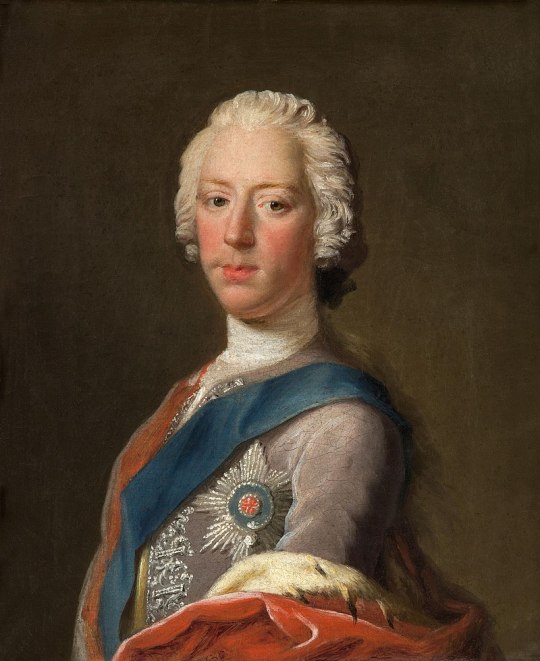
Prince Charles Edward Stewart, AKA Bonnie Prince Charlie was born in Rome on December 31st 1720.
Charles Edward Louis John Casimir Sylvester Maria Stuart – to give him his full name, is one of the most talked about people in Scottish history, in my opinion the only person to come close to Charlie is Mary Queen of Scots.
His father, James Francis Edward Stuart, had been brought to Rome as an infant when his deposed father, James VII, received Papal support after fleeing London in 1689. James Francis married Maria Clementina, a Polish princess with a large inheritance, in 1719. After the failures of the second and third Jacobite Risings in Scotland at the beginning of the 18th century, the birth of a Stuart heir was heartening to the Jacobite cause.
The Christmas song, 'O Come All Ye Faithful, is said to have it’s origins in the Jacobite cause, a Durham University Professor claims “The meaning of the Christmas carol is clear: ‘Come and Behold Him, Born the King of Angels’ really means, Come and Behold Him, Born the King of the English – Bonnie Prince Charlie! “
Charles was charismatic and sociable from a young age, characteristics that would later compensate for his lack of skill in battle. As a royal heir, he was privileged and well educated, particularly in the arts. On myth I would like to dispel is that he could not speak English, in fact he spoke several languages, including enough Gaelic to be understood in Scotland, and he is said to have played the bagpipes. He was fair-faced and rather effeminate, characteristics that earned him the nickname “Bonnie Prince.”
As the son of the claimant and heir apparent to the throne of Great Britain, Charles was raised to believe in his divine right to an absolute monarchy, something I have covered many times in my posts, the divine right of kings was not just a Stuart belief, but was widespread in European history, a political doctrine in defence of monarchical absolutism. It was Charlies life’s purpose to ascend to the throne of Scotland, Ireland, and England, and it was this belief that ultimately lead to the so-called Young Pretender’s defeat, as his desire to capture London after securing Edinburgh exhausted his dwindling troops and supplies in the winter of 1745.
In order to reclaim the throne, James and Charles needed support from a powerful ally. After the death of Louis XIV in 1715, France revoked its support of the Jacobite cause, but in 1744, with the War of Austrian Succession waging across the continent, James managed to secure financing, soldiers, and ships from the French to advance into Scotland. At the same time, the aging James named 23-year-old Charles Prince Regent, tasking him with taking back the crown.
In February 1744, Charles and his French company sailed for Dunkirk, but the fleet was destroyed in a storm shortly after departure Louis XV refused to redirect any more effort from the ongoing War of Austrian Succession to the Jacobite cause, so the Prince pawned the famed Sobieska Rubies to finance two manned ships, one of which was immediately decommissioned by a waiting British warship. Undeterred, Charles pressed on, stepping foot in Scotland for the first time in July 1745.
The standard was raised for the Bonnie Prince in August at Glenfinnan, comprised mostly of destitute Scots and Irish farmers, a mix of Protestants and Catholics. The army marched south through the autumn, taking Edinburgh in early September.Some think it would have been wise for Charles to wait out the ongoing war on the continent in Edinburgh, a move that would have exhausted the Hanoverian army
Instead, motivated by a desire to claim the throne in London, Charles marched his army into England, getting as close as Derby before being forced to retreat. The Jacobites retreated north, up to the highland capital, Inverness, Charles’ most important holding.
Government troops were not far behind, and a bloody battle was fast approaching. On the night of April 15, 1746, the Jacobites attempted a surprise attack, but they got lost in the marsh and darkness, rendering the attempt a dismal failure. As the sun rose the next morning, Charles ordered his Jacobite army, sleep-deprived men, to prepare for battle on the flat, muddy Drumossie Moor at Culloden.
In less than an hour, the Government army obliterated the Jacobites, and Charles was nowhere to be found. In tears, the Young Pretender had fled the battlefield.
Charles spent the subsequent months in hiding. He was introduced to Flora MacDonald, who disguised him as her maid, “Betty Burke” and smuggled him safely to the Isle of Skye. He eventually crossed the mainland once more to catch French ships en route to the continent. In September 1746, Charles Edward Stuart left Scotland for the last time.
After a few years searching for Jacobite support, Charles returned to Rome, blaming his senior commanders for the loss at Culloden. He fell into drunkenness, and in 1772 married Princess Louise of Stolberg, a girl 30 years his junior. The pair had no children, leaving Charles without an heir, though he did have one illegitimate daughter, Charlotte. Charles died in Charlotte’s arms in 1788.
In the aftermath of Culloden, Jacobitism became shrouded in myth, and over the years, the Bonnie Prince became the symbol of a valiant but doomed cause rather than who some portray as a privileged, unskilled prince that abandoned his army.
In reality, it was, at least in part, the impatience and impudence of Charles Edward Stuart that simultaneously cost him his throne and permanently ended the Jacobite cause.
#scotland#scottish#history#the stuarts#the stewarts#bonnie prince charlie#jacobites#scots-italian#England#great britain
30 notes
·
View notes
Photo
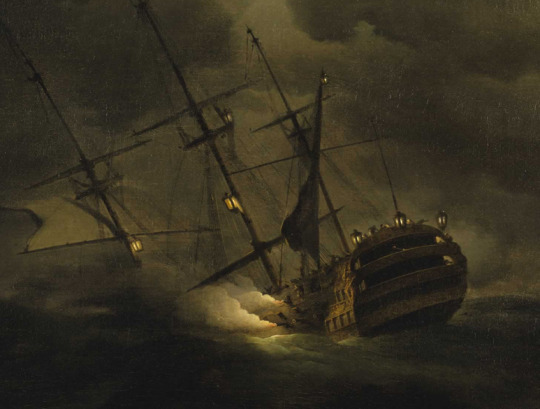
Loss of HMS Victory, 4 October 1744
By Peter Monamy.
26 notes
·
View notes